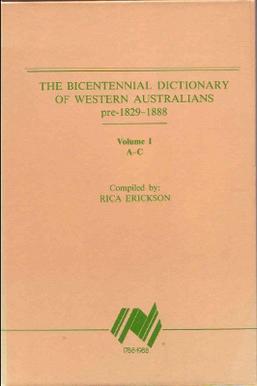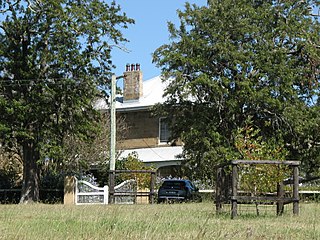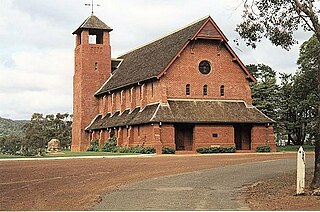
The Scheyville National Park is a protected national park that is located in the northwestern suburbs of Sydney in New South Wales, in eastern Australia. The 920-hectare (2,300-acre) national park is situated approximately 40 kilometres (25 mi) northwest of the Sydney central business district, northeast of Windsor, near the settlement of Scheyville. Longneck Lagoon lies in the northern section of the park. It was added to the New South Wales State Heritage Register on 9 April 2010.

Sir James Mitchell, was an Australian politician. He served as premier of Western Australia from 1919 to 1924 and from 1930 to 1933, as leader of the Nationalist Party. He then held viceregal office from 1933 to 1951, as acting governor from 1933 to 1948 and governor of Western Australia from 1948 until his death in 1951.

John Scaddan, CMG, popularly known as "Happy Jack", was Premier of Western Australia from 7 October 1911 until 27 July 1916.

The Swan River Colony, established in June 1829, was the only British colony in Australia established on the basis of land grants to settlers. Under the conditions stipulated by the Colonial Office, settlers would be granted land in proportion to the value of assets and labour that they brought to the colony. To ensure "productive" use of land, settlers were not given full title to their grants until they had been sufficiently "improved". The system of land grants in the Swan River Colony continued until 1832, after which crown land was disposed of by sale at auction.

Manjimup is a town in Western Australia, 307 kilometres (191 mi) south of the state capital, Perth. The town of Manjimup is a regional centre for the largest shire in the South West region of Western Australia. At the 2016 census, Manjimup had a population of 4,349.

Baldivis is a semi-rural residential suburb 46 kilometres (29 mi) south of Perth, Western Australia, and 11 kilometres (6.8 mi) southeast of the regional centre of Rockingham. It is located within the City of Rockingham local government area.

The Midland Railway of Western Australia (MRWA) was a railway company that built and operated the Midland line in Western Australia. It was listed on the London Stock Exchange. Although having its headquarters in London, it had no association with the English Midland Railway.

South Western Highway is a highway in the South West region of Western Australia connecting Perth's southeast with Walpole. It is a part of the Highway 1 network for most of its length. It is about 406 kilometres (252 mi) long.

The Dictionary of Western Australians and the related Bicentennial Dictionary of Western Australians are two multi-volume biographical dictionaries containing details of European and non-European settlement in Western Australia from the foundation of the Swan River Colony in 1829 until 1888.
Northcliffe is a town located in the lower South West region of Western Australia, about 28 kilometres (17 mi) south of the town of Pemberton. It is part of the Shire of Manjimup. At the 2006 census, Northcliffe had a population of 412. Currently, Northcliffe serves a population of around 770 people within the town and surrounding areas. Approximately 31% of the population have post-secondary qualifications.

The Murray River is a river in the southwest of Western Australia. It played a significant part in the expansion of settlement in the area south of Perth after the arrival of British settlers at the Swan River Colony in 1829. It should not be confused with the Murray River in southeastern Australia, which is the longest river in the country.

Soldier settlement was the settlement of land throughout parts of Australia by returning discharged soldiers under soldier settlement schemes administered by state governments after World War I and World War II. The post-World War II settlements were co-ordinated by the Commonwealth Soldier Settlement Commission.

Dunmore House is a heritage-listed residence at 557 Paterson Road, Bolwarra Heights, City of Maitland, New South Wales, Australia. It was built from 1830 to 1833 by William and Andrew Lang. It was added to the New South Wales State Heritage Register on 16 August 2012.

Fairbridge, Western Australia is a former farm school near Pinjarra in Southwest Western Australia. It is now used predominantly for education, school and community camps and tourism purposes. It is also home to Fairbridge College, a curriculum and reengagement secondary school.

The Northcliffe branch, also known as the Northcliffe section or Picton to Northcliffe line, is the railway route between Picton and Northcliffe in Western Australia.

The Baldivis tramway, also referred to as the Peel Estate tramway or Peel tramline, was a short-lived tramway, originally planned to be operating from Jandakot railway station to Karnup, in Western Australia. The line was constructed to support the post-World War I Group Settlement Scheme at the Peel Estate in Baldivis but was never fully completed, only reaching as far as Wellard. The line existed from 1920 to 1925 and was designed to transport supplies to the settlement scheme and to carry harvested timber on the return journey.

The Peel Main Drain is a drainage canal in the southern suburbs of Perth, Western Australia. Construction of the canal commenced in 1920 to drain the wetlands in the area as part of the post-World War I Group Settlement Scheme at the Peel Estate. The canal stretches from Banjup, where it starts just north of Banjup Lake, to Karnup, where it discharges into the Serpentine River. The drain has a catchment area of 120 square kilometres.

The Peel Estate was an area of land in the south of Perth, Western Australia, predominantly in what is now the City of Kwinana, City of Rockingham and the Shire of Serpentine–Jarrahdale. The estate twice featured prominently in Western Australian history.
Dixvale is a rural locality of the Shire of Manjimup in the South West region of Western Australia. Dixvale is located on the traditional land of the Bibulman people of the Noongar nation. In the 2021 census, Dixvale had a population of 68 people.
Quinninup is a rural locality of the Shire of Manjimup in the South West region of Western Australia. The South Western Highway forms much of its eastern border, as does the Warren River to the north. The eastern parts of Greater Dordagup National Park are located within Quinninup.



















